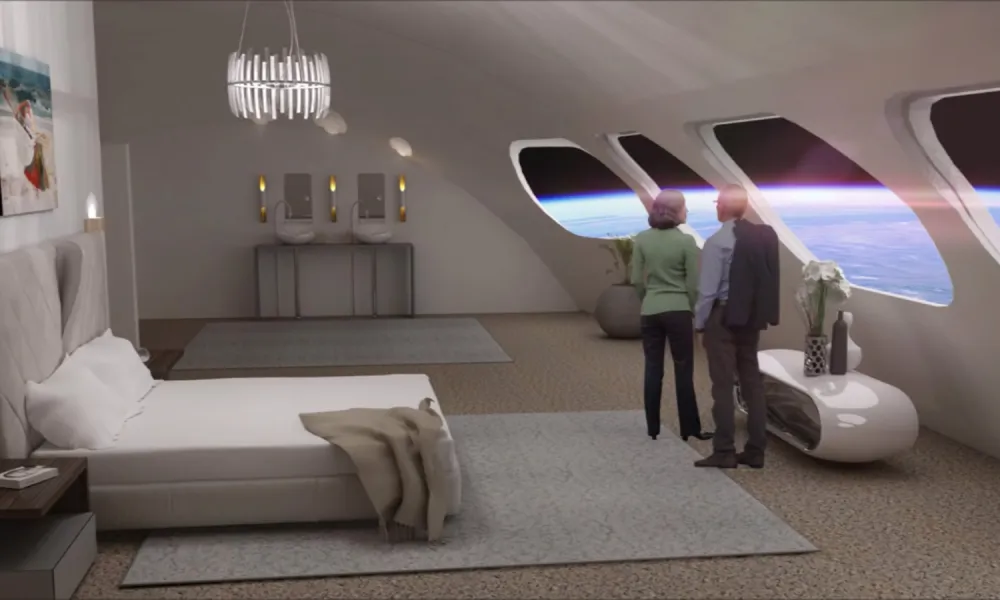News
First space hotels scheduled to open in 2025, are designed for tourism and business

Space development company Orbital Assembly has released concept designs of two space hotels that are planned to open in 2025 and 2027, and will cater to tourists and business travelers alike.
The hotels, which were originally conceived by The Gateway Foundation, are shaped like giant wheels connected by a system of elevator shafts that rotates as it orbits the Earth as guests enjoy their stay, scientists conduct research, and businesses manufacture products in space aboard the station.
Concept drawings for the The Voyager-class Space Station and Pioneer Station were published on Orbital Assembly’s website this week, giving Earthlings a first glimpse at the extraterrestrial hotels.
“The Voyager-class Space Station is OAC’s flagship project. Offering luxury accommodations and unprecedented opportunities for leisure, research, entertainment, and manufacturing,” reads the OA site.
“The large rotating stations are designed to produce varying levels of artificial gravity by increasing or decreasing the rate of rotation. Artificial, or simulated, gravity is essential to long term habitation in space. The station has been designed to accommodate commercial and manufacturing partners as well as national space agencies conducting low gravity research.”
The Voyager Station, set to open in just three years, is set to hold up to 400 people at a time. Newer concept Pioneer Station would hold only 28 people at once.
“Pioneer-class stations will be the first habitable platforms capable of providing artificial gravity, unlocking unprecedented opportunities for research, tourism, and long duration spaceflight. The Pioneer Class of space station marks a fundamental shift away from existing station architectures,” says Orbital.
The designs show a hotel not unlike the ones we are used to on Earth, but with extraordinary views of space. The hotels would include restaurants and many of the usual facilities guests are used to, but they would find themselves experiencing a change in the level of gravity as they traveled throughout the structure.
In a 2019 interview with CNN, Orbital Assembly COO Tim Allatore explained, “The station rotates, pushing the contents of the station out to the perimeter of the station, much in the way that you can spin a bucket of water — the water pushes out into the bucket and stays in place. Near the center of the station there would be no artificial gravity, but as you move down the outside of the station, the feeling of gravity increases.”
Terry A. Hurlbut has been a student of politics, philosophy, and science for more than 35 years. He is a graduate of Yale College and has served as a physician-level laboratory administrator in a 250-bed community hospital. He also is a serious student of the Bible, is conversant in its two primary original languages, and has followed the creation-science movement closely since 1993.
-

 Civilization3 days ago
Civilization3 days agoDC Pipe Bomb Arrest Raises Questions About Christopher’s Wray’s FBI
-

 Civilization4 days ago
Civilization4 days agoThe Legal Logic Behind U.S. Operations Against Narco-Terrorist Networks
-

 Executive4 days ago
Executive4 days agoNewsom’s ‘National Model’ for Homeless Wracked by Fraud
-

 Executive3 days ago
Executive3 days agoWhen You’re in a Hole, Stop Digging
-

 Education3 days ago
Education3 days agoWaste of the Day: Taxpayers Subsidize Football Coach Severance
-

 Executive2 days ago
Executive2 days agoWaste of the Day: Obamacare Failed Test, Approved Fraudulent Subsidies
-

 Civilization2 days ago
Civilization2 days agoPence Calls on Trump To Fire RFK Jr Over Abortion Drug
-

 Executive4 days ago
Executive4 days agoWaste of the Day: Feds Pay Nonprofits That Sue the Government


